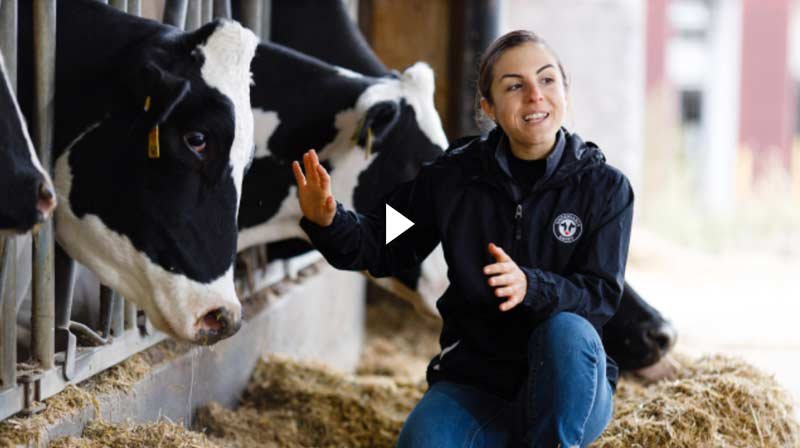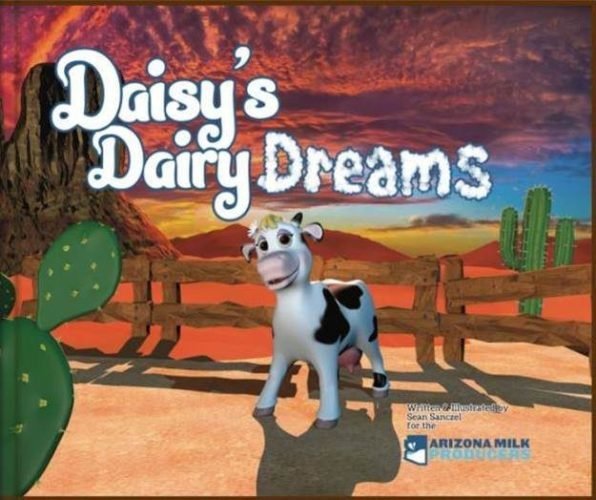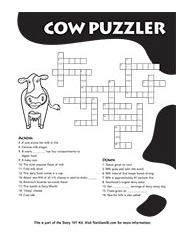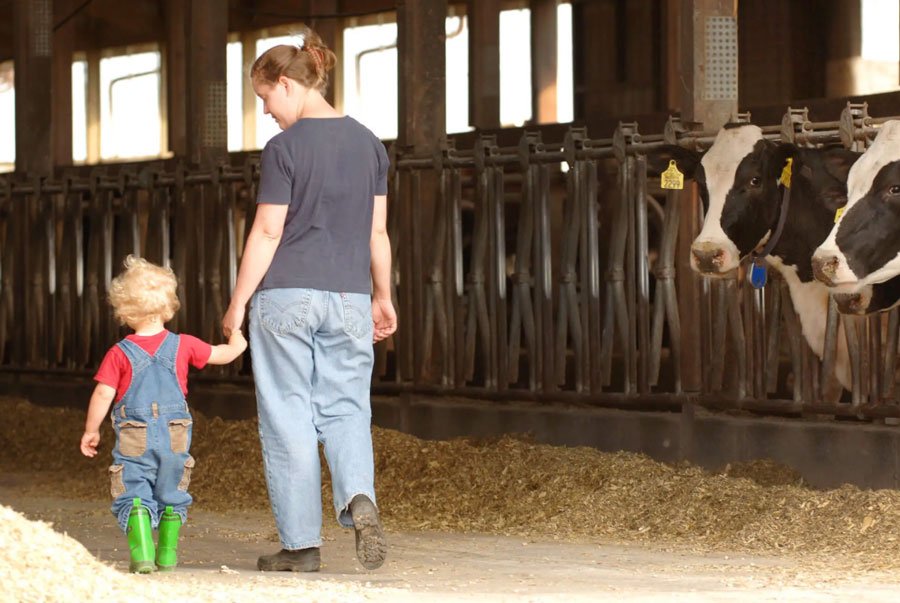Words, phrases and acronyms that are commonly used on the farm:
Name that Dairy Cow
Each one is different than the udder.
• Holstein: A black and white dairy cow that originated in the province of Friesland, the Netherlands. ThecHolstein is the most popular breed and has the highest milk production of all dairy cattle.
•Jersey: A breed of dairy cattle that is smaller than other breeds and known for their big eyes and honeybrown color. The Jersey is renowned for the high butterfat content of its milk.
• Brown Swiss: Originally from the Swiss Alps, this type of dairy cow is gray-brown in color. Their milk averages 4% butterfat and 3.4% protein, which makes it ideal for cheese production.
• Ayrshire: Originated from the County of Ayr in Scotland, the average mature Ayrshire cow weighs 1,000 – 1,300 lbs. and has red markings that vary in color from orange to brown.
• Guernsey: A small, cream-and-brown breed of dairy cattle that was bred on the British Island of Guernsey and descended from cattle stock brought from nearby Normandy.
• Milking Shorthorn: Large in size, Milking Shorthorn is a breed of reddish-brown and white dairy cattle that originated in Britain.
Dairy Cow Diet
DYK More than 50% of cow feed is actually grass and we’re not talking about your lawn (farmers call it hay and silage)
•Forage: Cow feed that is high in fiber, such as whole plants of corn, small grains (such as oats, barley or wheat), legumes and grasses.
• Hay: Dried feed such as rye, alfalfa, clover, grass and oats. A hay field is mowed and the trimmings dry in the sun for two to three days.
• Silage: Fermented, high-moisture forage that is eaten by grazing animals such as dairy cows. Silage is often made from grass crops such as corn or sorghum and retains a great deal of the plant’s nutrients.
• TMR (Total Mixed Ration): A nutritionally balanced blend of forage and grain ingredients mixed by a machine to a specific ration that allows cows to eat the desired proportion of forages.
Feed: Dairy Nutritionist-Recommended, Cow-Approved, 4-Chambered Stomach Fuel
Feed ingredients that make cows go “Mmm-oo” to unlock nutrition for “You-oo”
• Almond Hulls: Outer covering of the almond kernel and shell that serves as a fiber source.
• Brewers Grains: Extracted residue of barley malt from the processing of beer and other grain products such as cereal that serves as a protein supplement.
• Cottonseeds: Unprocessed oilseed that has been separated from the cotton fiber used to make clothing and other items. Cottonseeds provide a source of fat and fiber.
• Distillers Grains: Obtained following the removal of ethyl alcohol through the distillation process. Used as a protein supplement, these grains include barley, cereals, corn, rye, sorghum and wheat.
• Hominy: Mixture of corn bran, corn germ and part of the starchy portion of corn kernels from the production of grits. It’s a good energy source of fiber, starch and fat.
• Molasses: Byproduct of sugar production from cane or sugar beets. Molasses helps improve the palatability
of certain feeds, especially with calves, and also is a good source of niacin.
• Citrus Pulp and Peels: The remains of making grapefruit and orange juice is dried and converted into a pelletlike feed that is nutritious and can be mixed with other feed that makes for a tasty feast.
•”Chew their cud”: When cows chew partially digested food that has been returned to their mouth to be chewed again. A cow may spend seven hours a day eating food and an additional 10 hours a day chewing her cud. Why? Cows must chew their food twice in order to digest it properly.
• Rumen: The largest of the four compartments in a cow’s stomach. The rumen allows cows to regurgitate forage and re-chew their cud for further digestion.
•Silo: A storage facility on farms that is designed to store silage.
•Feed Wagon/Feed Truck: Basically a giant blender on wheels that mixes the TMR and then delivers it.
Cow-ology
DYK all dairy cows are female?
• Calf: A young female dairy animal before she has matured.
• Heifer: A female dairy animal that has yet to give birth to a calf.
• Dry Cows: A period of time during which a cow is not producing milk. This lasts between 50-70 days when a cow is preparing to give birth to a calf, which then begins a new lactation period.
• Fresh Cow: A cow that has recently given birth to a calf.
• Dam: The mother of a calf.
• Sire: The father of a calf.
• Bull: Adult male dairy animal.
Cow Spa
From temperature-controlled barns to showers, fans and water misters, cow comfort is the first priority for dairy farmers.
• Freestall Barn: A barn that houses and protects the dairy herd and provides a comfortable resting area. It includes individual stalls and bedding for each cow, and access to clean water and feed 24 hours a day. Cows
are not restrained and are free to enter, lie down, drink water, rise and leave the stall as they desire.
• Hutch: An individual housing unit designed for young calves. .
• Pasture: Land at a dairy farm that is lush with grasses or legumes and is used for grazing dairy cows.
• Bedding: Material used to absorb moisture and provide a comfortable cushion where cows can rest. Includes
straw, sawdust, wood chips, sand, ground limestone, separated manure solids, shredded newspaper, corn stalks, bark, peanut hulls, sunflower hulls and rice hulls.
• Brush: A brush attached to a motor that rotates on a horizontal arm. Cows love them! It helps keep them
clean and comes in handy if they need a back scratch!
• Manis & Pedis: Cows’ hooves are trimmed at least once a year and sometimes more if there are issues.
• Cowlick: Supposedly named for the swirling pattern made on hair when a cow licked its calves, a cowlick is a
patch of hair that grows in another direction than the rest and sticks upward.
• Milking Parlor: A specialized area on the dairy farm where cows are milked two or three times a day. Parlors come in many types, including flat barn, herringbone, parallel, swing, walk-through and rotary.
• Rotary Milking Parlor or Milking Carousel: Cows stand on a circular raised platform, allowing the farmer to attach the machine from below. The platform rotates very slowly, allowing cows to enter and exit the platform at regular intervals.
Cow Bling
More than just for show
• Ear Tags: A device similar to an earring that farmers place in the ears of their animals to identify each member of the herd with a number allowing farmers to maintain accurate health and milking records.
• FitBit: Believe it or not some dairy farmers use the equivalent of a fit bit on dairy cows to help identify and record changes in cow’s daily movement (e.g. eating, chewing, time standing, time spent resting).
Moo-scellaneous
• FARM (Farmers Assuring Responsible Management): A program that ensures America’s dairy farmers provide the highest standards when it comes to animal care to provide wholesome milk. www.nationaldairyfarm.com
• YC (Young Cooperators): A program to help educate and build leadership ability in young dairy farmers.






